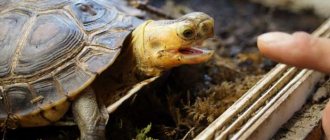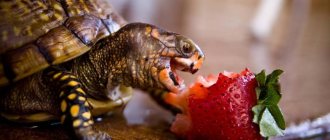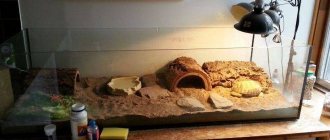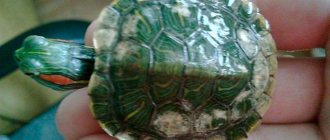Drinking process in turtles
Research and observation of reptiles have been carried out for a long time, however, whether the turtle has a need to drink is still not known exactly. This is due to the fact that some representatives of the turtle world live quietly without drinking water, while their relatives drink liquid from a reservoir. The turtle's body is not adapted to consume water, so when drinking it can pour out of the reptile's nostrils and also flow down its neck. The moisture that a reptile needs comes to it through the skin and through the food it eats. Therefore, some representatives do not show a desire to drink water. A turtle can reach for a drinking bowl only when there is an urgent need.
General Tips
For both types of turtles, the water must be clean, without impurities. You should not collect it from the tap if you are not sure of the quality of the tap water - this can harm your turtle. Also, the water should be warm - reptiles are cold-blooded animals, which means they hibernate in the cold. It is necessary to ensure that the water is heated to the temperature required for a particular type of turtle, most often 25-30 degrees.
Most turtles need to have their claws trimmed regularly if they become overgrown and interfere with your pet's ability to move around. Aquatic turtles molt—the top layer of plates that make up their shell peels off. There is no need to worry, this is a completely natural and painless phenomenon for turtles.
Of course, each type of turtle has a special approach, but all of them, without exception, need water to exist, so take care of its decent quality.
Is there a need for a drinking bowl?
A fairly large number of breeders supply their future pet’s home with a drinking bowl. However, the reptile does not need the constant presence of liquid, since when drinking, all the water flows out of the holes on the turtle's head. Sometimes some reptile owners regard this pet behavior as some kind of disease and come for a consultation with a veterinarian.
However, the pet is not sick with anything, but is simply not fit to drink water the way other pets do. The required amount of moisture enters through the turtle’s skin, or along with food, therefore, a drinking bowl is not a necessary attribute in the reptile’s home. Sometimes the presence of water can even cause discomfort and irritation in your pet.
Habitat arrangement
The reptile takes a long time to get used to new environmental conditions. To make the adaptation process easier for her, think in advance and buy everything you need to keep and care for your turtle at home.
You will need:
- Container - terrarium or aquarium.
- A small house where the animal will sleep and hide.
- Heating lamp.
- UV lamp.
- Containers for food and water.
- Thermometer.
- Substrate.
- Caches.
A waterfowl reptile needs a separate aquaterrarium with a capacity of about 100 liters. Water should take up most of it. Red-eared turtles require a space of more than 200 liters.
Additionally, a filter is installed. Turtles excrete a lot of waste products, and unfiltered water will be very dirty. Change at least 20% of the fluid every week.
Tap water is purified from chlorine and heavy metals before use. Add special conditioners to the terrarium liquid - they will neutralize turtle feces.
Use a heater to maintain the water temperature at 25-28 ºС. If it is cold, the animal will become lethargic, its metabolic processes will slow down, and there will be problems with digestion.
This condition is unacceptable - it leads to the death of the turtle. To maintain the desired temperature, install a thermostat in the terrarium.
Equip a separate area of land with a bridge where the animal can get out of the water. The island should be comfortable and smooth. Place a UV lamp on it.
Ultraviolet light promotes the release of vitamin D, without which calcium cannot be absorbed. A deficiency of this element leads to rickets, a fragile shell.
The temperature of the island of land should be 30-32 ºС. Turn off the UV lamp and heating at night.
Place stones the size of the turtle's head or larger at the bottom of the terrarium so that it cannot swallow them. Decorate your reptile's home with artificial plants - the living ones will be eaten. Use primer solely for aesthetics.
If you have a land turtle, it is advisable to choose glass housing for it. But a wooden box will also work if one side is transparent. The conditions in it - filling, lighting, additional elements - should be close to the natural environment.
Make sure there is good ventilation. The holes should be located at different levels on opposite sides of the terrarium.
Cover the bottom of your pet's home with hay. It is easy to change, it is comfortable to lie on, and the animal will not be able to swallow straws, which cannot be said about sand or small pebbles.
You can only use large pebbles on which the turtle will sharpen its claws. Corn mulch or cellulose filler is also used as bedding. They are easy to clean and a turtle can happily burrow into them.
Build a sleeping place from a plastic flower pot cut in half or use a wooden house for rodents.
Securely secure the feeder and water bowl. The turtle should not turn over “kitchen utensils” while walking around the terrarium.
Buy a mineral stone: the animal will chew on it and get extra calcium, and also sharpen the rhamphotec (beak). Install a heating lamp near the feeder and drinker; do not allow the air temperature to drop below 30ºC.
An ultraviolet lamp will imitate the sun's rays. The required power of the device is 10-12% UVB (UVB 200).
It's also worth knowing that reptiles transmit serious diseases, such as salmonella. Wash your hands thoroughly after direct contact with an animal.
How to provide a turtle with water?
When studying this issue, owners are interested in what to feed a land turtle? From all of the above, we can conclude that to ensure normal moisture levels, the turtle needs proper nutrition. Therefore, plants in the diet are a mandatory component. However, you should not give only solid vegetation; it is also necessary to provide your pet with succulent types of plants, such as cabbage and lettuce leaves, which will provide the reptile with the right amount of liquid. Another succulent leaves are young leaves of clover and dandelion. If you provide your pet turtle with succulent food, it will not need an additional source of moisture.
Another option to ensure the required level of moisture in the reptile’s body is to bathe the pet. You should put the turtle in water, and it will absorb the required amount of moisture. The turtle will not drink the water in which it bathes.
REPRODUCTION
Puberty occurs at the age of 6 years. Make sure turtles are completely healthy before breeding. Main conditions: hibernation, dense nutrition and warmth.
At home, you can distinguish turtles by the following characteristics: first, females are larger than males in size, second, if you turn the male over, you can see a small concavity on the shell, which is necessary for mating, third, the female’s tail is much thicker and larger, fourth, the female’s cloaca located at the very base of the tail.
Select several females so that they are larger in size than the males. Boys are placed in the enclosure with girls, and not vice versa. It is better if there are more females, let the males fight for the females, but only under your control, so as not to injure each other.
Video: how to care for a pet?
strong>A pregnant turtle is easy to spot: it becomes restless, hardly eats, and begins to fence off its territory. Offer her a choice of foods, but be sure to add calcium. Pregnancy lasts 2 months, but the turtle can tolerate it if it has not completely equipped a place for the eggs.
The baby turtles, about 3 cm in size, can sit in the shell for another 3 days after pecking. Only after this period, if they do not have enough strength to get out, can you intervene. Be careful if twin turtles appear, they are much weaker than single ones. Tie it around the umbilical cord, which is connected with thread. Then they separate themselves.
Babies should be kept separately! Living conditions are suitable for adults, only the food should be softer, irradiation should be carried out with a 10% UVB lamp. Under good conditions, your pet will live with you for 40 years.
Priming
Do you need soil in an aquaterrarium? Turtle lovers are debating this issue. According to some, the soil makes cleaning difficult and does not provide any benefit to reptiles. Others argue that without a loose foundation, a turtle's limbs may become deformed.
The amount of soil on the surfaces is proportional to the size of the container and ranges from 3 to 10 cm. Use sand and large pebbles . Various driftwood and plastic plants are suitable for decoration.
The following materials are dangerous for pets , so their use is undesirable:
- small pebbles;
- granite screening;
- chipped stones (with sharp edges).
Price
The cost of an individual varies from 200 rubles to 150,000 or more for rare species. The refusenik can be found on websites for free.
| Name | Price (rubles) |
| Greek, Mediterranean (Testudo graeca) | 2160–4800 |
| Leopard, Panther (Stigmochelys pardalis) | 3840–7680 |
| Indian starfish (Geochelone elegans) | 5000–12000 |
| Redfoot, Charcoal (Chelonoidis carbonaria) | 3840–4800 |
| Madagascar radiata (Astrochelys radiata) | 24000 |
| Central Asian (Agrionemys horsfieldii) | 500–3000 |
Prices depend on characteristics:
- floor;
- age;
- rarity of the species.
Harmful products
Some plants are harmful to reptiles:
- medicinal plants containing alkaloids;
- poisonous plants of the nightshade and buttercup families;
- dieffenbachia;
- elodea;
- spurge;
- azalea;
- hydrangea;
- daffodils;
- ambulia;
- saffron;
- cyclamen;
- digitalis;
- delphinium;
- lily;
- jasmine;
- lupine.
The following products are contraindicated:
- boiled, fried, boiled food;
- sausages, minced meat, pates;
- citrus;
- tops, root crops of radishes, potatoes and radishes;
- avocado;
- eggplant;
- gooseberry;
- parsley;
- cabbage;
- rhubarb;
- berry, fruit seeds;
- porridge;
- dairy products;
- bread;
- food for warm-blooded animals;
- crab sticks;
- tomatoes.
Products available in limited quantities:
- apples;
- corn;
- radish;
- asparagus;
- squid;
- legumes;
- cereal grains, mustard;
- fatty fish and meat;
- pineapples;
- raspberries, strawberries;
- watermelon and melon;
- locusts, crickets, cockroaches;
- onion garlic;
- basil;
- too sweet fruits and berries.











